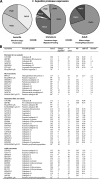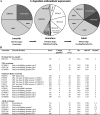An integrated transcriptomics and proteomics analysis of the secretome of the helminth pathogen Fasciola hepatica: proteins associated with invasion and infection of the mammalian host
- PMID: 19443417
- PMCID: PMC2722771
- DOI: 10.1074/mcp.M900045-MCP200
An integrated transcriptomics and proteomics analysis of the secretome of the helminth pathogen Fasciola hepatica: proteins associated with invasion and infection of the mammalian host
Abstract
To infect their mammalian hosts, Fasciola hepatica larvae must penetrate and traverse the intestinal wall of the duodenum, move through the peritoneum, and penetrate the liver. After migrating through and feeding on the liver, causing extensive tissue damage, the parasites move to their final niche in the bile ducts where they mature and produce eggs. Here we integrated a transcriptomics and proteomics approach to profile Fasciola secretory proteins that are involved in host-pathogen interactions and to correlate changes in their expression with the migration of the parasite. Prediction of F. hepatica secretory proteins from 14,031 expressed sequence tags (ESTs) available from the Wellcome Trust Sanger Centre using the semiautomated EST2Secretome pipeline showed that the major components of adult parasite secretions are proteolytic enzymes including cathepsin L, cathepsin B, and asparaginyl endopeptidase cysteine proteases as well as novel trypsin-like serine proteases and carboxypeptidases. Proteomics analysis of proteins secreted by infective larvae, immature flukes, and adult F. hepatica showed that these proteases are developmentally regulated and correlate with the passage of the parasite through host tissues and its encounters with different host macromolecules. Proteases such as FhCL3 and cathepsin B have specific functions in larvae activation and intestinal wall penetration, whereas FhCL1, FhCL2, and FhCL5 are required for liver penetration and tissue and blood feeding. Besides proteases, the parasites secrete an array of antioxidants that are also highly regulated according to their migration through host tissues. However, whereas the proteases of F. hepatica are secreted into the parasite gut via a classical endoplasmic reticulum/Golgi pathway, we speculate that the antioxidants, which all lack a signal sequence, are released via a non-classical trans-tegumental pathway.
Figures



Similar articles
-
Collagenolytic activities of the major secreted cathepsin L peptidases involved in the virulence of the helminth pathogen, Fasciola hepatica.PLoS Negl Trop Dis. 2011 Apr 5;5(4):e1012. doi: 10.1371/journal.pntd.0001012. PLoS Negl Trop Dis. 2011. PMID: 21483711 Free PMC article.
-
Characterization and differential expression of cathepsin L3 alleles from Fasciola hepatica.Mol Biochem Parasitol. 2013 Jul;190(1):27-37. doi: 10.1016/j.molbiopara.2013.06.001. Epub 2013 Jun 13. Mol Biochem Parasitol. 2013. PMID: 23770026
-
Exploring the Fasciola hepatica tegument proteome.Int J Parasitol. 2011 Nov;41(13-14):1347-59. doi: 10.1016/j.ijpara.2011.08.003. Epub 2011 Oct 5. Int J Parasitol. 2011. PMID: 22019596
-
Controversial aspects of the life cycle of Fasciola hepatica.Exp Parasitol. 2016 Oct;169:81-9. doi: 10.1016/j.exppara.2016.07.010. Epub 2016 Jul 28. Exp Parasitol. 2016. PMID: 27475124 Review.
-
Fasciola hepatica cathepsin L-like proteases: biology, function, and potential in the development of first generation liver fluke vaccines.Int J Parasitol. 2003 Sep 30;33(11):1173-81. doi: 10.1016/s0020-7519(03)00171-1. Int J Parasitol. 2003. PMID: 13678633 Review.
Cited by
-
Extracellular vesicles in parasitic diseases.J Extracell Vesicles. 2014 Dec 22;3:25040. doi: 10.3402/jev.v3.25040. eCollection 2014. J Extracell Vesicles. 2014. PMID: 25536932 Free PMC article.
-
Comparative transcriptome profiling approach to glean virulence and immunomodulation-related genes of Fasciola hepatica.BMC Genomics. 2015 May 9;16(1):366. doi: 10.1186/s12864-015-1539-8. BMC Genomics. 2015. PMID: 25956885 Free PMC article.
-
Secretome: clues into pathogen infection and clinical applications.Genome Med. 2009 Nov 30;1(11):113. doi: 10.1186/gm113. Genome Med. 2009. PMID: 19951402 Free PMC article.
-
Transcriptome profiles of the protoscoleces of Echinococcus granulosus reveal that excretory-secretory products are essential to metabolic adaptation.PLoS Negl Trop Dis. 2014 Dec 11;8(12):e3392. doi: 10.1371/journal.pntd.0003392. eCollection 2014 Dec. PLoS Negl Trop Dis. 2014. PMID: 25500817 Free PMC article.
-
Long noncoding RNA MALAT-1: A versatile regulator in cancer progression, metastasis, immunity, and therapeutic resistance.Noncoding RNA Res. 2024 Feb 1;9(2):388-406. doi: 10.1016/j.ncrna.2024.01.015. eCollection 2024 Jun. Noncoding RNA Res. 2024. PMID: 38511067 Free PMC article. Review.
References
-
- Garcia H. H., Moro P. L., Schantz P. M. ( 2007) Zoonotic helminth infections of humans: echinococcosis, cysticercosis and fascioliasis. Curr. Opin. Infect. Dis. 20, 489– 494 - PubMed
-
- Andrews S. J. ( 1999) The life-cycle of Fasciola hepatica, in Fasciolosis ( Dalton J. P. ed) pp. 1– 29, CAB International, Oxford
-
- Mas-Coma S., Bargues M. D., Esteban J. G. ( 1999) Human fasciolosis, in Fasciolosis ( Dalton J. P. ed) pp. 411– 434, CAB International, Oxford
-
- Fairweather I., Threadgold L. T., Hanna R. E. ( 1999) Development of Fasciola hepatica in the mammalian host, in Fasciolosis ( Dalton J. P. ed) pp. 47– 111, CAB International, Oxford
-
- Hewitson J. P., Harcus Y. M., Curwen R. S., Dowle A. A., Atmadja A. K., Ashton P. D., Wilson A., Maizels R. M. ( 2008) The secretome of the filarial parasite, Brugia malayi: proteomic profile of adult excretory-secretory products. Mol. Biochem. Parasitol. 160, 8– 21 - PubMed
Publication types
MeSH terms
Substances
Grants and funding
LinkOut - more resources
Full Text Sources

